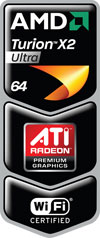How AMD will Save Windows Vista
 I was on hand for the AMD announcement of their Turion X2 Ultra mobile processor and the 7 Series chipset for mobile computers and I couldn't help feeling like this was the turning point for Windows Vista performance. In my own experiences with Vista, the key limiting factor for everything important to me — video editing, high definition video playback, and even day-to-day visual user experience — is graphics processing. My Dell D620 routinely crashes thanks to the Nvidia graphics card inside. My desktop Vista installation was a graphics slug until I upgraded to a GPU with 512MB of dedicated video RAM. AMD's annoucement of the 7 Series chipset, should help make sure that doesn't happen to anyone smart enough to buy a computer with the 7 Series chipset inside.
I was on hand for the AMD announcement of their Turion X2 Ultra mobile processor and the 7 Series chipset for mobile computers and I couldn't help feeling like this was the turning point for Windows Vista performance. In my own experiences with Vista, the key limiting factor for everything important to me — video editing, high definition video playback, and even day-to-day visual user experience — is graphics processing. My Dell D620 routinely crashes thanks to the Nvidia graphics card inside. My desktop Vista installation was a graphics slug until I upgraded to a GPU with 512MB of dedicated video RAM. AMD's annoucement of the 7 Series chipset, should help make sure that doesn't happen to anyone smart enough to buy a computer with the 7 Series chipset inside.
AMD's announcement is all about video (okay, there was some other stuff, but I ignored most of it). The chipset is designed from the ground up to be able to handle HD video playback. No more jerky framed HD video playback. No more praying your video editor won't crash while you're trying to edit those AVCHD movies (unless of course the software is buggy). This is a huge leap forward because most people are buying laptops these days. And most of those laptops are using some kind of integrated graphics processing rather than a dedicated GPU. The integrated graphics processors, while technically being "Vista capable" are not up to the task of running the "glass" interface of Vista, let alone playing back HD, and editing is completely out of the question.
Upping the game even further, if you buy a new laptop with the 7 Series chipset and a dedicated ATI video card inside, you can take advantage of some bridging technology that makes use of both graphics processors where appropriate. It's smart enough to optimize for using the dedicated card when you're plugged in and the chipset GPU when you're not, helping improve battery life (according to AMD by up to 90 minutes, which I'll believe when I see). All-in-all this is a huge win specifically for Windows Vista, because it finally means getting a laptop with Vista on it won't make it a complete dog for video tasks we are all coming to expect.
Thankfully this doesn't seem to be limited to those giant desktop replacement laptops either. ASUS already has a laptop in the market (not in the US yet, unfortunately) with a mere 12-inch screen, HDMI out, and the 7 series chipset handling HD like a champ. If I can get my hands on one, the ASUS will be my replacement for the frustrations I've had with the Dell D620 over the past 18 months. If you're in the market for a new laptop and care about HD video as part of your purchase process, look for the AMD Turion X2 logo, you won't be disappointed. And if recently bought a PC with integrated graphics, you can solve most video frustrations by spending an extra $150 and getting a dedicated video card.